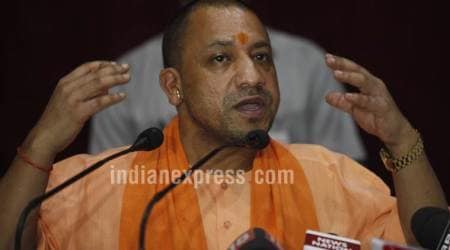 Students at a madarsa in Mau Aima, Allahabad. Express photo by Ritesh Shukla
Students at a madarsa in Mau Aima, Allahabad. Express photo by Ritesh Shukla
By half past seven, most of the 350 students had assembled at the 115-year-old Jamia Islamia madarsa in the town of Mau Aima, chatting while teachers taped Tricolour balloons on either side of classroom doors and stuck paper flags on table tops.
Microphones in place, the Tricolour secure atop a pole with rose petals sprinkled at the base, artificial flowers placed on tables for the guests of honour, the children, aged between three and sixteen, began falling into queues.
Teachers were dressed in their best, with a Tricolour badge on the chest, while students, wearing their blue-grey uniforms, added a touch of the Tricolour by sporting paper caps and satin ribbons. “Adil, why have you come in coloured clothes? Go back and change,” Saifullah, an assistant teacher rebuked a little boy who had sheepishly walked in wearing an orange shirt and jeans. Another boy was pulled up for rolling up his shirt sleeves.
As shy, giggling participants took their place before the flag post and teachers handed the last few scuffling children their flags, a young Zainab Manzoor, a post graduate in Arabic from Allahabad University who teaches the language at the madarsa, walked in, flashing a gold Samsung Galaxy Note Edge. Some other teachers, including principal Mohammad Akmal, also began readying their phones for photographs.
“It’s a good phone. I have borrowed it from my family to record the programme,” said Manzoor, bestowed with the chief responsibility of ensuring that the celebrations were photographed and videographed as per the UP government notice to all madarsas.
Teachers at the madarsa said they have not been asked to formally submit photos and videos to the government but they are keeping the clips as a measure of precaution because of the August 3 notice.
Guest of honour Nadeem Intakhab said the madarsa had been one of the few pre-Independence era madarsas. President of the Jamia Islamia society which runs the co-ed Arabic-Persian medium madarsa, Intakhab said his ancestors had donated a plot to the madarsa in 1902. The madarsa which teaches children up to class 12 in the town of Mau Aima, roughly 40 km from Allahabad, is affiliated to the Uttar Pradesh Madarsa Education Board.
Once all the guests were in and the chatter died down, teachers took their positions on either side of the gathering and a group of senior girls huddled at the microphone to lead the programme. The Tricolour was hoisted at 8 am to the national anthem. The girls, all sporting Tricolour plastic cowboy hats over their pin-up hijabs, led with Iqbal’s ‘Saare Jahan se Achha’, the 350 strong-student body singing along.
Manzoor and her colleagues also sang, slightly distracted with having to hold up smartphones to record the event. “We have been celebrating Independence Day and Republic Day for years. This is a school. What else will we hold programmes on if not for this?”
Intakhab later said, looking around at the 8-room school with its unfinished second storey.
“The previous years we would begin at around 9 am,” Saifullah said. The Allahabad district minority officer, Prakash Tiwari, in charge for nearly 15 years, said all the 300 registered madarsas in the district have been celebrating Independence Day ever since.
“The madarsas always hold celebrations on August 15 and January 26. And no punitive action will be taken against those not celebrating it. The notice to videograph the event was for the purpose of maintaining archives, so that children can revisit them and enjoy them through the year. But we have been getting photos and videos on WhatsApp from madarsas across the district, though we have not formally asked for them,” Tiwari said.
Once all the children, mostly sent in by poor parents who work in the powerlooms and cracker factories of Mau Aima, seated themselves on the rug-mats around an old banyan tree, an hour-long programme followed.
“Kuch baat hai ki hasti mit-ti nahi hamari/Sadiyon raha hai dushman daur-e-zaman hamara,” Meeraj Asif, one of the guests, recited Iqbal.
“When we say Indians were slaves under the British, it does not necessarily mean they all were in jail. Indians were slaves before Independence because they were under the watch of the British. When they were free from British rule and came unto themselves, they were then truly free. That is the meaning of freedom,” he said.
After teachers narrated events from the freedom struggle, Adil, a young student, was called on to recite a poem and Maryam a Na’at (religious poem). Intakhab then came up to the microphone and told the children that the true meaning of Azadi is the relentless pursuit of knowledge and education.
“We have come so far since Independence, but we have lagged behind in the sphere of education and employment. Instead of the pen and the schoolbag, there are weapons in the hands of the youth. That is why we have to pull up our socks and study hard,” another speaker said.
Mahmood Ali, a class-four employee in the school, shuffled around, placing furniture, readying crockery for tea and snacks and the play equipment for the games session after the programme. “Our ancestors fought this war of Independence against the British and we are the free citizens and keepers of this country. So we have to work hard to take our country to the greatest heights and protect it from ignorance,” another speaker said.
More songs and poems from students followed and the programme drew to a close at 11 am, each student sent off with a laddoo wrapped in saffron pouches. “Independence Day and Republic Day celebrations are so much fun. We will play now, we are free today,” Sana Bano, a 14-year-old student of class 7, said.

